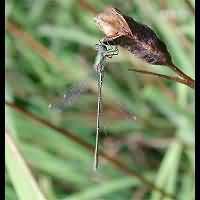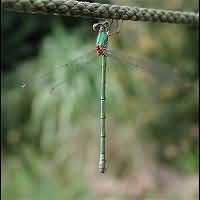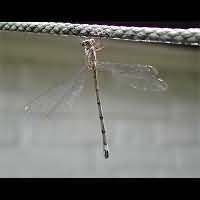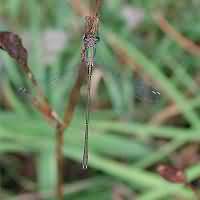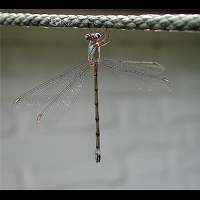[All pictures of garden wildlife on this page are thumbnails. Click on any thumbnail for a large format to be displayed.]
Willow Emerald Damselfly, Green Emerald Damselfly (Lestes viridis)
The Willow Emerald Damselfly belongs to a small group of 4 rather similar metallic green damselflies. Among these it is easily identified, for it is the biggest, males never turn blueish and the marking in the wings is whitish. Usually the eyes are brownish and not blueish as in the other species. The Willow Emerald Damselfly may reach a length of 45 to 50mm, while the wingspan varies from 50 to 60mm.
Like in all damselflies and Dragonflies mating is done in a wheel: males grab a female behind her head and she places the end of her body near the end of the males's thorax. Mating usually takes place in trees or bushes near the water. After mating the female lets go, but the male keeps on grabbing her behind the head. They now are a so-called tandem. In this position egg-laying commences. While most damselflies lay their eggs in the water, the Willow Emerald Damselfly deposits her eggs in crevices in the bark of trees, especially branches growing over the water. She prefers willows to other trees to lay her eggs in. In the evening however one sometimes sees females depositing eggs by themselves. The eggs overwinter and hatch next spring. Out of the egg comes the legless, smooth and very light prolarva. It is capable of jumping, something it must do should it have been fallen not into but near water. This prolarva stage takes a short time only. Some damselflies mould within a few seconds. In the Willow Emerald Damselfly it takes the animal several minutes to mould for the first time. The nymph usually hunts at the bottom and grows incredibly fast, for after some 3 months a new adult may appear.
Due to the fact the eggs are being laid in tree bark, we'll find this species in waters surrounded by trees and shrubs. The size of the water doesn't matter much: a lake will do, but so will a ditch. Brackish water though is avoided. Both females and males may migrate considerable distances and may turn up in gardens as well. In gardens they'll never be as numerous as some Dragonflies though. The Willow Emerald Damselfly usually hunts from one and the same place. After a hunt they'll return to the same place over and over again. Photographers don't have to go running after them, just wait for them at their usual spot. They'll accept your presence very soon and are excellent models indeed. A very common species on the European continent, but not a British species. Only found in Sussex in 1980 and in Kent in 1992.
This species is also called the Green Emerald Damselfly. Scientifically also known as Chalcolestes viridis.
Like in all damselflies and Dragonflies mating is done in a wheel: males grab a female behind her head and she places the end of her body near the end of the males's thorax. Mating usually takes place in trees or bushes near the water. After mating the female lets go, but the male keeps on grabbing her behind the head. They now are a so-called tandem. In this position egg-laying commences. While most damselflies lay their eggs in the water, the Willow Emerald Damselfly deposits her eggs in crevices in the bark of trees, especially branches growing over the water. She prefers willows to other trees to lay her eggs in. In the evening however one sometimes sees females depositing eggs by themselves. The eggs overwinter and hatch next spring. Out of the egg comes the legless, smooth and very light prolarva. It is capable of jumping, something it must do should it have been fallen not into but near water. This prolarva stage takes a short time only. Some damselflies mould within a few seconds. In the Willow Emerald Damselfly it takes the animal several minutes to mould for the first time. The nymph usually hunts at the bottom and grows incredibly fast, for after some 3 months a new adult may appear.
Due to the fact the eggs are being laid in tree bark, we'll find this species in waters surrounded by trees and shrubs. The size of the water doesn't matter much: a lake will do, but so will a ditch. Brackish water though is avoided. Both females and males may migrate considerable distances and may turn up in gardens as well. In gardens they'll never be as numerous as some Dragonflies though. The Willow Emerald Damselfly usually hunts from one and the same place. After a hunt they'll return to the same place over and over again. Photographers don't have to go running after them, just wait for them at their usual spot. They'll accept your presence very soon and are excellent models indeed. A very common species on the European continent, but not a British species. Only found in Sussex in 1980 and in Kent in 1992.
This species is also called the Green Emerald Damselfly. Scientifically also known as Chalcolestes viridis.

© Copyright 1998-2024 gardensafari.net (Hania Berdys)

 English / engels
English / engels  Dutch / nederlands
Dutch / nederlands